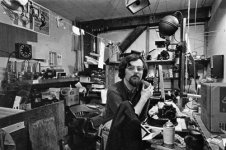willie_901
Veteran
"Here’s a question I can’t answer, one which I really don’t know the answer but truly wish I did. Is a digital Leica, the M240 or M10, a worthwhile camera?"
In terms of dynamic range and sensitivity the M10 compares well to current DSLRs. The M-Monochrome's sensitivity outperforms all current cameras with 24 X 36 mm cameras. The M-240's performance is lower. But this alone would not stop me from buying a M240 instead of a DSLR - especially if I owned M and, or LTM lenses.
My conclusions are based on Bill Claff's data. Claff's results are objective as they are computed from statistical analysis of unrendered raw-file data. This data is not normalized to differences in sensor area, but this is not important for the cameras I chose to compare below.
Dynamic Range vs ISO. Note, while Claff's term photographic dynamic range is always lower than the engineering definition of dynamic range, the difference is a constant.
The M10 is iso-invariant to within 1/3 stop. This indicates ISO electronic amplification adds practically no noise to sensor output at the native (base) ISO setting. In other words, photon noise dominates perceived image quality until ISO settings are extremely high.
Input-referred read noise indicates the relative nose level of the sensor assembly when no light is present. It does not include noise sources from the ADC or order electronic circuits. Again, the M10 does very well.
Perceived image quality is affected by other factors. Besides lens rendering, sensor cover glass thickness, IR-filter characteristics, color-filter array properties and micro-lens assembly design play important roles.
The M10 is worthwhile by any criteria I can imagine. The M240 is a cost-effective option for this who own M and, or LTM lenses. The M-Monochrome stands alone. A monochrome version of the M10 would significantly outperform any other 24 X 34mm camera on the market today.
In terms of dynamic range and sensitivity the M10 compares well to current DSLRs. The M-Monochrome's sensitivity outperforms all current cameras with 24 X 36 mm cameras. The M-240's performance is lower. But this alone would not stop me from buying a M240 instead of a DSLR - especially if I owned M and, or LTM lenses.
My conclusions are based on Bill Claff's data. Claff's results are objective as they are computed from statistical analysis of unrendered raw-file data. This data is not normalized to differences in sensor area, but this is not important for the cameras I chose to compare below.
Dynamic Range vs ISO. Note, while Claff's term photographic dynamic range is always lower than the engineering definition of dynamic range, the difference is a constant.
The M10 is iso-invariant to within 1/3 stop. This indicates ISO electronic amplification adds practically no noise to sensor output at the native (base) ISO setting. In other words, photon noise dominates perceived image quality until ISO settings are extremely high.
Input-referred read noise indicates the relative nose level of the sensor assembly when no light is present. It does not include noise sources from the ADC or order electronic circuits. Again, the M10 does very well.
Perceived image quality is affected by other factors. Besides lens rendering, sensor cover glass thickness, IR-filter characteristics, color-filter array properties and micro-lens assembly design play important roles.
The M10 is worthwhile by any criteria I can imagine. The M240 is a cost-effective option for this who own M and, or LTM lenses. The M-Monochrome stands alone. A monochrome version of the M10 would significantly outperform any other 24 X 34mm camera on the market today.


